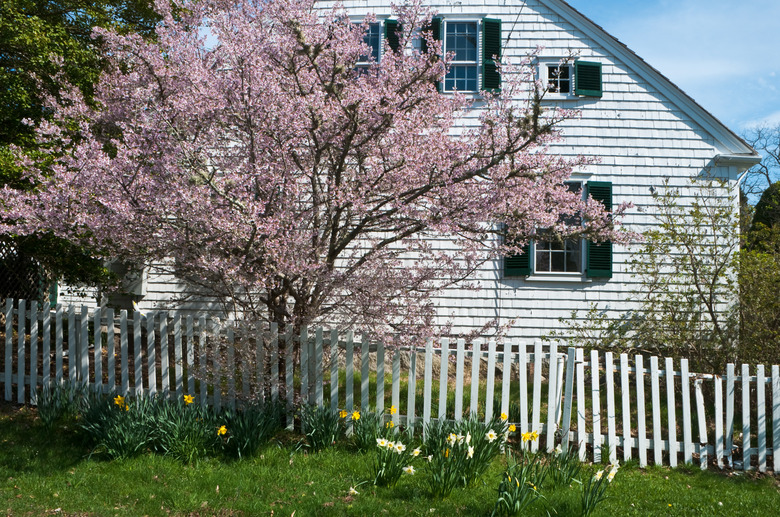How To Landscape A Cape Cod House
Originally designed to withstand the stormy, changeable weather of the northeast U.S. Atlantic coast, Cape Cod-style houses are ideal for a wide variety of settings. Their clean, simple lines, traditionally soft exterior colors and compact footprints are especially suited to small yards. Several landscaping styles share principles that enhance the crisp silhouette and modest formality of your Cape Cod house.
Step 1
Still highly popular for many housing styles, traditional minimalist design favors a smooth lawn, low foundation evergreen plantings and a subdued, limited color palette. This approach maintains the house as centerpiece of the property and produces a public face that is by and large consistent throughout the year. Low evergreens provide a frame for the house without blocking windows or light, and the predominantly dark greens set off the traditionally pale exterior colors of the house effectively. Evergreens can be pruned for a slightly more formal look. Touches of color can be added and varied with pots of seasonal annuals throughout the growing season. Keep walkways, driveways and stone walls within the blue-gray spectrum typical of rocks, gravel and shells on the Cape.
Formal Cape Landscaping
Step 1
Historically, formal landscaping and modest architecture are less at odds than you might expect. For early American homeowners, the natural world was not a place for relaxation and recreation. Garden designer Gunda Lass observes that early gardens depended on the regulation and control of nature, and the garden of a Cape Cod house today can still display a historic tension between regulation and enjoyment of the outdoors. Gardeners no longer need the rigid geometric beds that grew essential foods and herbs, but Cape Cod flower beds are often still rock-edged or walled. Rambler roses, wisteria and clematis display their colorful profusion trained on a wood arbor rather than rambling along a porch trellis and roof. Low evergreens like boxwood tidily define planting and walking areas. Picket fencing perfectly illustrates the balance between control and modest beauty that characterizes a historically accurate Cape Cod garden.
Step 2
- Still highly popular for many housing styles, traditional minimalist design favors a smooth lawn, low foundation evergreen plantings and a subdued, limited color palette.
- Low evergreens provide a frame for the house without blocking windows or light, and the predominantly dark greens set off the traditionally pale exterior colors of the house effectively.
Cape Cottage Gardening
Step 1
Although originating in more sheltered English village climate conditions, elements of cottage gardening can be successfully incorporated into landscaping a Cape Cod-style house. While the full-to-overflowing planting style of some cottage gardens can visually overwhelm a Cape house, cottage-style emphases on local plants and a blooming cycle that covers most of the growing season are excellent guidelines for Cape Cod landscaping. In nearly all parts of the country, a native plant garden gives the house an established quality, and the undramatic exterior of the house can highlight some modest native plants that are overlooked in more dramatic settings. Varieties of many long-season bloomers like asters, coneflower, phlox and tickweed provide perennial color at the 1- to 4-foot heights suitable to Cape Cod-style gardens. Perennials with interesting foliage, like lady's mantle, coral bells and lamb's ears add further interest. Look for clumping types of native grasses to add further textures and colors.
Common Design Elements
Step 1
Whether you prefer to take a minimalist, historically formal or cottage approach to landscaping your Cape, appropriate styles share several basic principles. Scale is very important in successful design and plant choices. Capes are often 1 1/2 stories rather than two full stories in height, and foundations are often set close to the ground. Evergreens and perennials in the 1- to 4-foot range keep the foundation line clear and do not interfere with low-set windows. Choose small trees, defined by the Arbor Day Foundation as 30 feet or less in height, to keep size from overwhelming the house. Placing trees out on the lawn rather than close to the house keeps them from overshading the house and recalls a traditional method to prevent storm damage. Choose blooming plants that give your overall landscape a soothing, cheering look. Avoid dramatic foliage and flowers that create visual confusion or overstimulation. Use intense color in small amounts, in window boxes or containers, rather than scattering it all over the garden.
Step 2
- Although originating in more sheltered English village climate conditions, elements of cottage gardening can be successfully incorporated into landscaping a Cape Cod-style house.
- While the full-to-overflowing planting style of some cottage gardens can visually overwhelm a Cape house, cottage-style emphases on local plants and a blooming cycle that covers most of the growing season are excellent guidelines for Cape Cod landscaping.
Garden Structures and Hardscaping
Step 1
Maintain a strong structural presence with fencing, benches, an arbor or a pergola, bird houses and window boxes. Keep walkways, driveways and stone walls within the blue-gray spectrum typical of rocks, gravel and shells on the Cape. Choose a simple curve, rather than a more intricate shape, when designing a path or driveway and choose gravel or rough pavers over smoother stone, cement or asphalt.
